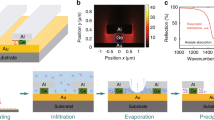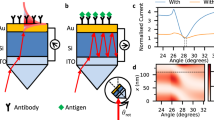Abstract
Electronic interactions at the nanoscale represent one of the fundamental problems of nanotechnology. Excitons and plasmons are the two most typical excited states of nanostructures, which have been shown to produce coupled electronic systems1,2,3,4,5,6,7,8,9,10,11. Here, we explore these interactions for the case of nanowires with mobile excitons and nanoparticles with localized plasmons and describe the theoretical formalism, its experimental validation and the potential practical applications of such nanoscale systems. Theory predicts that emission of coupled excitations in nanowires with variable electronic confinement is stronger, shorter and blue-shifted. These predictions were confirmed with a high degree of accuracy in molecular spring assemblies of CdTe nanowires and Au nanoparticles, where we can reversibly change the distance between the exciton and the plasmon. The prepared systems were made protein-sensitive by incorporating antibodies in the molecular springs. Modulation of exciton–plasmon interactions can serve as a wavelength-based biodetection tool, which can resolve difficulties in the quantification of luminescence intensity for complex media and optical pathways.
This is a preview of subscription content, access via your institution
Access options
Subscribe to this journal
Receive 12 print issues and online access
$259.00 per year
only $21.58 per issue
Buy this article
- Purchase on Springer Link
- Instant access to full article PDF
Prices may be subject to local taxes which are calculated during checkout




Similar content being viewed by others
References
Tang, Z. & Kotov, N. A. One-dimensional assemblies of nanoparticles: preparation, properties, and promise. Adv. Mater. 17, 951–962 (2005).
Zhang, J., Coombs, N., Kumacheva, E., Lin, Y. & Sargent, E. H. A new approach to hybrid polymer-metal and polymer-semiconductor particles. Adv. Mater. 14, 1756–1759 (2002).
Zhang, H. et al. Aligned two- and three-dimensional structures by directional freezing of polymers and nanoparticles. Nature Mater. 4, 787–793 (2005).
Niemeyer, C. M. Functional hybrid devices of proteins and inorganic nanoparticles. Angew. Chem. Int. Edn 42, 5796–5800 (2003).
Dyadyusha, L. et al. Quenching of CdSe quantum dot emission, a new approach for biosensing. Chem. Commun. 3201–3203 (2005).
Oh, E. et al. Inhibition assay of biomolecules based on fluorescence resonance energy transfer (FRET) between quantum dots and gold nanoparticles. J. Am. Chem. Soc. 127, 3270–3271 (2005).
Fu, A. et al. Discrete nanostructures of quantum dots/Au with DNA. J. Am. Chem. Soc. 126, 10832–10833 (2004).
Gueroui, Z. & Libchaber, A. Single-molecule measurements of gold-quenched quantum dots. Phys. Rev. Lett. 93, 166108 (2004).
Lee, J., Govorov, A. O. & Kotov, N. A. Bioconjugated superstructures of CdTe nanowires and nanoparticles: Multistep cascade Foerster resonance energy transfer and energy channeling. Nano Lett. 5, 2063–2069 (2005).
Nikoobakht, B., Burda, C., Braun, M., Hun, M. & El-Sayed, M. A. The quenching of CdSe quantum dots photoluminescence by gold nanoparticles in solution. Photochem. Photobiol. 75, 591–597 (2002).
Sarathy, K. V., Thomas, P. J., Kulkarni, G. U. & Rao, C. N. R. Superlattices of metal and metal-semiconductor quantum dots obtained by layer-by-layer deposition of nanoparticle arrays. J. Phys. Chem. B 103, 399–401 (1999).
Lee, J., Govorov, A. O., Dulka, J. & Kotov, N. A. Bioconjugates of CdTe nanowires and Au nanoparticles: Plasmon-exciton interactions, luminescence enhancement, and collective effects. Nano Lett. 4, 2323–2330 (2004).
Dulkeith, E. et al. Fluorescence quenching of dye molecules near gold nanoparticles: Radiative and nonradiative effects. Phys. Rev. Lett. 89, 203002 (2002).
Ipe, B. I. & Thomas, K. G. Investigations on nanoparticle-chromophore and interchromophore interactions in pyrene-capped gold nanoparticles. J. Phys. Chem. B 108, 13265–13272 (2004).
Lakowicz, J. R. et al. Advances in surface-enhanced fluorescence. J. Fluorescence 14, 425–441 (2004).
Levin, C. S. et al. Chain-length-dependent vibrational resonances in alkanethiol self-assembled monolayers observed on plasmonic nanoparticle substrates. Nano Lett. 6, 2617–2621 (2006).
Kang, Y., Erickson, K. J. & Taton, T. A. Plasmonic nanoparticle chains via a morphological, sphere-to-string transition. J. Am. Chem. Soc. 127, 13800–13801 (2005).
Atwater, H. A., Maier, S., Polman, A., Dionne, J. A. & Sweatlock, L. The new p-n junction: Plasmonics enables photonic access to the nanoworld. Mater. Res. Soc. Bull. 30, 385–389 (2005).
Citrin, D. S. Coherent excitation transport in metal-nanoparticle chains. Nano Lett. 4, 1561–1565 (2004).
Wei, Q. H., Su, K. H., Durant, S. & Zhang, X. Plasmon resonance of finite one-dimensional Au nanoparticle chains. Nano Lett. 4, 1067–1071 (2004).
Wang, G. & Murray, R. W. Controlled assembly of monolayer-protected gold clusters by dissolved DNA. Nano Lett. 4, 95–101 (2004).
Maier, S. A. et al. Local detection of electromagnetic energy transport below the diffraction limit in metal nanoparticle plasmon waveguides. Nature Mater. 2, 229–232 (2003).
Chen, S. et al. Amperometric hydrogen peroxide biosensor based on the immobilization of horseradish peroxidase (HRP) on the layer-by-layer assembly films of gold colloidal nanoparticles and toluidine blue. Electroanalysis 18, 471–477 (2006).
Westenhoff, S. & Kotov, N. A. Quantum dot on a rope. J. Am. Chem. Soc. 124, 2448–2449 (2002).
Lee, J., Govorov, A. O. & Kotov, N. A. Nanoparticle assemblies with molecular springs: Nanoscale thermometer. Angew. Chem. Int. Edn 117, 7605–7608 (2005).
Govorov, A. O. et al. Exciton-plasmon interaction and hybrid excitons in semiconductor-metal nanoparticle assemblies. Nano Lett. 6, 984–994 (2006).
Yamamoto, Y. et al. Site-specific PEGylation of a lysine-deficient TNF-a with full bioactivity. Nature Biotechnol. 21, 546–552 (2003).
Chapman, A. P. PEGylated antibodies and antibody fragments for improved therapy: A review. Adv. Drug Delivery Rev. 54, 531–545 (2002).
Heller, D. A. et al. Optical detection of DNA conformational polymorphism on single-walled carbon nanotubes. Science 311, 508–511 (2006).
Jana, N. R., Gearheart, L. & Murphy, C. J. Seeding growth for size control of 5–40 nm diameter gold nanoparticles. Langmuir 17, 6782–6786 (2001).
Obare, S. O., Hollowell, R. E. & Murphy, C. J. Sensing strategy for lithium ion based on gold nanoparticles. Langmuir 18, 10407–10410 (2002).
Zhu, T., Vasilev, K., Kreiter, M., Mittler, S. & Knoll, W. Surface modification of citrate-reduced colloidal gold nanoparticles with 2-mercaptosuccinic acid. Langmuir 19, 9518–9525 (2003).
Acknowledgements
The authors thank J. H. Bahng, Biomedical Engineering Department, University of Michigan, for useful discussion and assistance in biological experiments. The project was supported by NSF (N.A.K. and A.O.G.), DARPA, AFOSR, NIH (N.A.K.) and Ohio University (A.O.G.).
Author information
Authors and Affiliations
Contributions
N.A.K. and J.L. carried out the experimental work and bio-assembly, whereas A.O.G. and P.H. carried out the theoretical study and modelling.
Corresponding authors
Ethics declarations
Competing interests
The authors declare no competing financial interests.
Supplementary information
Supplementary Information
Supplementary information (PDF 1511 kb)
Rights and permissions
About this article
Cite this article
Lee, J., Hernandez, P., Lee, J. et al. Exciton–plasmon interactions in molecular spring assemblies of nanowires and wavelength-based protein detection. Nature Mater 6, 291–295 (2007). https://doi.org/10.1038/nmat1869
Received:
Accepted:
Published:
Issue Date:
DOI: https://doi.org/10.1038/nmat1869
This article is cited by
-
Signatures of Plexcitonic States in Molecular Electroluminescence
Scientific Reports (2018)
-
Plasmon-induced carrier polarization in semiconductor nanocrystals
Nature Nanotechnology (2018)
-
Photoelectrochemical immunoassay of lipoprotein-associated phospholipase A2 via plasmon-enhanced energy transfer between gold nanoparticles and CdS QDs/g-C3N4
Analytical and Bioanalytical Chemistry (2018)
-
Chiroplasmonic DNA-based nanostructures
Nature Reviews Materials (2017)
-
Investigation on the Enhanced Fluorescence Emission from Self-Assembled Au Nanorod Film
Plasmonics (2017)



